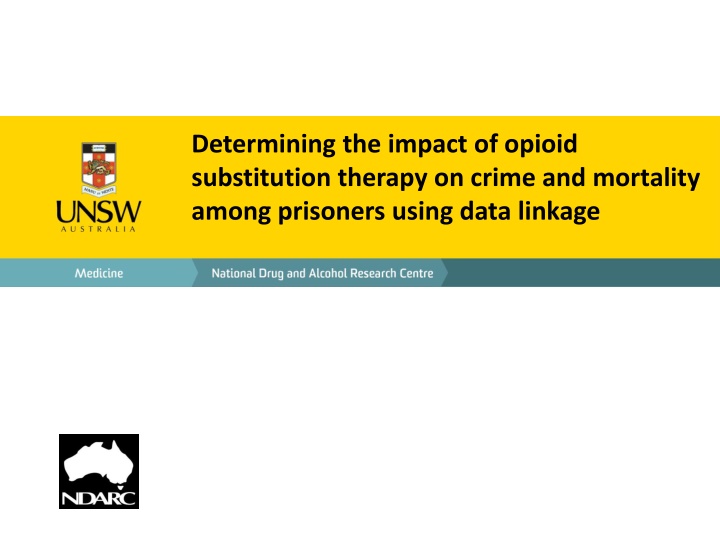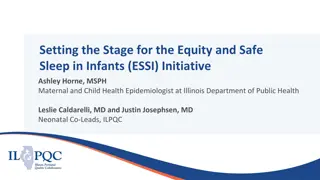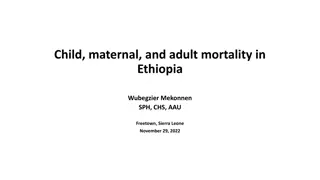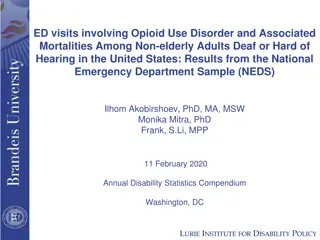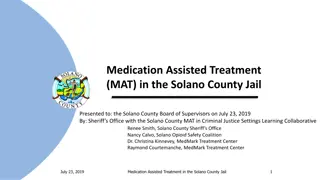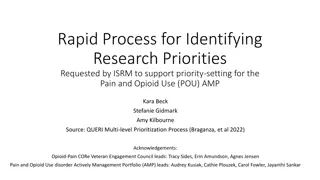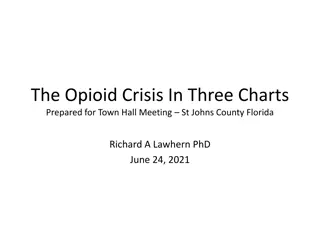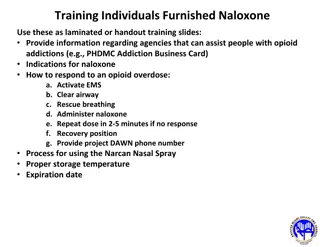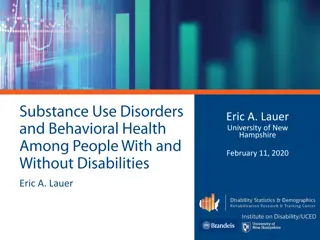Impact of Opioid Substitution Therapy on Crime & Mortality
This study evaluates the impact of opioid substitution therapy on crime and mortality among prisoners using data linkage. It explores patterns of OST, criminal justice system contact, and potential outcomes on mortality and crime rates.
Download Presentation

Please find below an Image/Link to download the presentation.
The content on the website is provided AS IS for your information and personal use only. It may not be sold, licensed, or shared on other websites without obtaining consent from the author.If you encounter any issues during the download, it is possible that the publisher has removed the file from their server.
You are allowed to download the files provided on this website for personal or commercial use, subject to the condition that they are used lawfully. All files are the property of their respective owners.
The content on the website is provided AS IS for your information and personal use only. It may not be sold, licensed, or shared on other websites without obtaining consent from the author.
E N D
Presentation Transcript
Determining the impact of opioid substitution therapy on crime and mortality among prisoners using data linkage
Collaborators and funding sources NDARC collaborators : Natasa Gisev, Sarah Larney, Jo Kimber, Marian Shanahan, Richard Mattick, Michael Farrell, Briony Larance, Judy Trevena, External collaborators: Tony Butler, Don Weatherburn, Amy Gibson, Timothy Dobbins Indigenous reference group: Anton Clifford, Michael Doyle, Megan Williams, Luke Bell NHMRC fellowships: Louisa Degenhardt, Sarah Larney Funding sources: NHMRC and the Australian Institute of Criminology (AIC) through the Criminology Research Grants Program Conflict of interest statement - untied educational grants from Reckitt Benckiser to conduct post-marketing surveillance of buprenorphine
Background Many people with opioid dependence have some form of contact with opioid substitution therapy (OST) People with opioid dependence also have increased contact with the criminal justice system To date, most studies estimating criminal risk among opioid- dependent individuals are based on convenience or respondent-driven sampling, which may not reflect offending rates in the total opioid-dependent population Using linked administrative datasets, we have evaluated patterns of OST and contact with the criminal justice system at the population level, and the potential impact of OST upon mortality and crime
Datasets DATASET DESCRIPTION Every authority to dispense methadone or buprenorphine in NSW as OST approved by NSW Health, 1985-2010 . Excludes clinical trial participants or those receiving treatment in other states. Around 48,000 people in total since 1985; 15,600 new entrants (from 1stAugust 2001). Internally linked dataset of all finalised court appearances in the Local, District and Supreme Courts of NSW between 1993-2011 (n= 639,386 charges in our cohort). Internally linked dataset of all custody episodes obtained from the NSW Department of Corrective Services from 2000-2011 (n=16,715 episodes in our cohort). Mortality data collected from each of the State and Territory Births, Deaths and Marriage Registers. Information includes date, state, and causes of death (primary causes for all records, secondary causes for deaths occurring 1997 and later) up to March 2012. NSW Pharmaceutical Drugs of Addiction System (PHDAS) Bureau of Crime Statistics and Research (BOCSAR) Reoffending Database (ROD) AustralianInstitute of Health and Welfare National Deaths Index (NDI)
What we have covered in our study: Natural history of criminal justice system involvement among opioid dependent people, 1993-2011; Extent of imprisonment of opioid dependent people, 2000-2012; Predictors of treatment retention, including potential differences between buprenorphine and methadone; Differences in OST engagement and crime among Aboriginal and Torres Strait Islanders; Gender differences in OST engagement; Impact of OST provision in prison upon in-prison mortality; Impact of OST on mortality following release from prison; Association of opioid substitution therapy (OST) and retention in OST on crime rates among opioid-dependent people; Cost effectiveness of OST in reducing mortality post-release
Some of our previously reported findings: 76% of the cohort had at least one criminal charge (80% males, 68% females); most commonly property (25%), traffic (17%) or violent (11%) offences Between 1993-2011, our cohort accounted for 13% of NSW court appearances - $311 million (2012 AUD); The contribution that cohort members made to these court costs varied dramatically: o the most frequently appearing 6% had 25% of appearances ($77million) o 10% accounted for 39% of all appearances ($120 million). o 27% accounted for 70% of all appearances ($218 million). Between 2000-2012, 37% of our cohort had at least one episode of incarceration lasting one or more days (43% males, 24% females) Indigenous men and women more likely to have been in prison, on more occasions, and for longer periods Cost of incarceration of this cohort between 2000-2012 was $3 billion
What we have covered in our study: Natural history of criminal justice system involvement among opioid dependent people, 1993-2011; Extent of imprisonment of opioid dependent people, 2000-2012; Predictors of treatment retention, including potential differences between buprenorphine and methadone; Differences in OST engagement and crime among Aboriginal and Torres Strait Islanders; Gender differences in OST engagement; Impact of OST provision in prison upon in-prison mortality; Impact of OST on mortality following release from prison; Association of opioid substitution therapy (OST) and retention in OST on crime rates among opioid-dependent people; Cost effectiveness of OST in reducing mortality post-release
Impact of OST upon mortality in prison Larney at el (2014) BMJ Open
Deaths in prison Deaths in prison raise questions as to the quality of care and supervision provided by correctional authorities Reflecting such concerns, deaths in prison usually result in extensive inquiries May also lead to litigation against correctional authorities and healthcare providers Unnatural deaths of particular concern (48-59% of deaths) Suicides, overdoses, violence, injuries Opioid dependent people may be at particular risk Drug withdrawal as a trigger for suicide Opioid overdose in custody
Cohort definition All people seeking OST, 1985-2012 People seeking OST who were incarcerated, 2000-2012 People seeking OST who died, 1985-2012 N=16,715 79% men 30% Indigenous 30 years (range 16-64 years) at cohort entry
Characteristics of incarcerations of opioid- dependent people in NSW (n=16,715) Median incarcerations 2 (1-34) Median duration of completed incarcerations 71 days (1 day-12 years) Prescribed OST at some point during an incarceration 12,852 (76.9%)
Method Crude mortality rates in and out of treatment Association between OST and mortality: Extended Cox models that allowed for discontinuous risk intervals OST exposure coded as time-dependent variable Other variables: sex, Indigenous status, age at release, and variables relating to treatment and criminal justice history (to account for potential differences in mortality risk among people with differing histories of criminal involvement, e.g. violent crime)
Deaths among the cohort in prison (n=51) Natural deaths Suicide Drug-induced Other injury Violent Unknown Between 2000-2010, deaths in this cohort accounted for 35% of all unnatural deaths in NSW prisons
Deaths in prison (n=51) Natural deaths Suicide Drug-induced Other injury Violent Unknown Out of OST In OST
Adjusted effect of OST on death in prison Cause of death Adjusted hazard ratio 95 % confidence interval All-cause deaths Unnatural deaths 0.26 0.13 0.13, 0.50 0.05, 0.35 i.e. hazard of unnatural death 87% lower while in OST Adjusted for sex, Indigenous status, age at prison reception, no. prior incarcerations, duration of prior incarcerations, any prior drug, violent or property offences
Deaths in first 4 weeks of prison (n=17) Natural deaths Suicide Drug-induced Other injury Violent Unknown Out of OST In OST
Adjusted effect of OST on death in first 4 weeks of prison Cause of death Adjusted hazard ratio 95 % confidence interval All-cause deaths Unnatural deaths 0.06 0.07 0.01, 0.48 0.01, 0.53 i.e. hazard of unnatural death 93% lower while in OST Adjusted for sex, Indigenous status, age at prison reception, no. prior incarcerations, duration of prior incarcerations, any prior drug, violent or property offences
Impact of OST upon mortality post-release from prison Degenhardt et al (2014) Addiction
Mortality post-release High risk of death following release from prison A large proportion of deaths in the 2 weeks after release are drug-induced Risk of overdose in the first 2 weeks is 3-11 times that in weeks 5-12 post-release OST reduces mortality of opioid-dependent people by more than one-half Does OST ameliorate risk of death among released opioid-dependent prisoners?
Method Cohort: people with an episode of OST who had also been released from prison at least once (n=16,453) Followed up until death or end of follow-up period Assumes chronic opioid dependence Any resulting bias would produce more conservative results, as people no longer using opioids would have lower baseline mortality risk Only those releases from prison during or after the first episode of OST were included (n= 60,161 prison releases)
Cohort definition All people seeking OST, 1985-2012 People seeking OST who were released from prison, 2000-2012 People seeking OST who died, 1985-2012 1,050 deaths after a prison release N=16,453 79% men 30% Indigenous 60,161 prison releases OST was prescribed in 51% of releases
Crude mortality rates per 1000PY in the first 4 weeks post-release OST exposure Partial 11.5 10.4 - - - Full 8.8 3.5 1.0 1.6 0.6 None 36.7 26.5 0.8 1.3 0.5 All-cause Accidental drug-induced Suicide Accidental injury Violence
OST and mortality post-release Results of multivariable Cox regression models: First 4 weeks post-release Time in OST associated with a 75% reduction in hazard of death (adj. HR 0.25; 95% CI: 0.12, 0.53) Total time at liberty post-release from prison Time in OST associated with an 83% reduction in hazard of death (adj. HR 0.17; 95% CI: 0.14, 0.20) Adjusted for sex, Indigenous status, age, no. prior incarcerations, duration of most recent incarceration, prior drug, violent or property offences, OST history
OST and crime Much discussion about the potential impact of OST upon offending behaviour We are examining a range of questions in this regard Crime before first entry to OST, contrasted with post-entry Association between cumulative retention in OST and crime Association between within OST-episode retention and crime Analyses still underway .
Offence rates according to time in OST (per 100PY) 140 120 100 4 years prior to OST entry 80 Time spent in OST 60 40 Time spent out of OST (post entry) 20 0 Any crime Violent offences Property offences Drug offences
Offence rates according to retention in OST (per 100PY) 100 90 80 70 3 months 60 6 months 50 9 months 40 12 months 30 20 10 0 Any crime Violent offending Property offences
Association between time in OST and time to first offence OST examined in a time- dependent fashion In multivariable models the hazard of being charged with any crime was reduced by 13% (adj. HR 0.87, 85%CI 0.83-0.92) Adjusted for age, sex and Indigenous status
Interaction between retention in OST and incident rate ratio of offending 16 3.5 14 3 Incident rate ratio 12 Incident rate ratio 2.5 10 2 8 6 1.5 No OST No OST 4 1 On OST On OST 2 0.5 0 733 245 489 977 1 1221 1465 1709 1953 2197 2441 2685 0 1 4 7 10 13 16 19 22 25 28 Number of days since start of treatment Number of days since start of treatment Generalised Poisson mixed model, limited to people who committed crime due to zero inflated data Within subject variation controlled for by including participant IDNUM Protective effect of treatment increases as OST retention increases
Discussion OST in prison is associated with a dramatic decrease in unnatural deaths in opioid-dependent prisoners Almost entirely eliminates deaths of opioid-dependent prisoners in first 4 weeks of incarceration OST is critical to minimising post-release mortality among opioid-dependent prisoners Higher rates of post-prison OST if someone is maintained on OST during incarceration Confirmation of finding that crime is lower during time spent in OST; also demonstrated that increasing retention increases the protective effect
References Degenhardt et al (2013). Engagement with the criminal justice system among opioid dependent people: Retrospective cohort study. Addiction, 108(12), 2152-2165. Degenhardt et al (2014). Imprisonment of opioid dependent people in New South Wales, Australia, 2000-2012: Retrospective linkage study. Australian and New Zealand Journal of Public Health, 38(2) 165-70. Larney et al (2014). Opioid substitution therapy as a strategy to reduce deaths in prison: retrospective cohort study. BMJ Open, 4:e004666. doi:10.1136/bmjopen-2013-004666. Degenhardt et al (2014). The impact of opioid substitution therapy on mortality post-release from prison: Retrospective data linkage study. Addiction, 109, 1306-1317. Gisev et al (2014). A comparative study of opioid substitution therapy utilization among opioid-dependent men and women. Drug and Alcohol Review, 33(5), 499-505. Gisev et al (2014). Treatment utilisation, offending and custody patterns among opioid-dependent individuals: comparison of Indigenous and non-Indigenous Australians. BMC Public Health, 14, 920. DOI: 10.1186/1471-2458-14-920 Burns et al (2015). A longitudinal comparison of retention in buprenorphine and methadone treatment for opioid dependence in New South Wales, Australia. Addiction. doi: 10.1111/add.12834 Gisev et al (submitted). The cost-effectiveness of opioid substitution therapy upon release in reducing mortality among prisoners with a history of opioid dependence. Addiction. Kimber et al (submitted). Comparing the mortality risk of methadone and buprenorphine substitution therapy: Retrospective cohort study. British Medical Journal.
